Projection of Extreme Summer Precipitation over Hubei Province in the 21st Century
Abstract
1. Introduction
2. Study Area
3. Data and Methods
3.1. Reanalysis of ERA5 Datasets
3.2. The Reginal Climate Model (RegCM)
3.3. Climate Indices
3.4. Methods of Analysis
4. Results
4.1. Validation of the Model Simulation and ERA5
4.2. Climatology of Rainfall over Hubei
4.3. Changes in Annual Mean Precipitation
4.4. Spatial Changes in EPIs
4.5. Temporal Changes in EPIs
4.6. Seasonal Analysis of Extreme Precipitation Indices in Summer for the Mid-21st Century (2046–2065)
4.6.1. Spatial Patterns
4.6.2. Temporal Patterns
4.7. Spatial–Temporal Changes of EPIs in Summer for the Late 21st Century (2078–2097)
4.7.1. Spatial Changes
4.7.2. Temporal Changes
5. Discussions and Conclusions
- The R10mm will increase significantly (p < 0.05) during the summer of the mid-21st century in the south northern parts, especially for Wuhan, Xiantao, Qianjiang, Jinzhuo, and Ezhou. The majority of EPIs, except CDD, are expected to rise. This indicates the need for more focus on disaster prevention during summer.
- Rx5day, R10mm, and SDII will all gradually decrease in the summer of the late 21st century toward the western parts. However, they may climb throughout other parts of Hubei, indicating an increase in the rates of drought during the summer of the 21st century.
- More focus needs to be placed on the rainstorms that are expected in Wuhan, Xiantao, Qianjiang, and Tianmen, particularly during the summer of the mid-21st century, where there may be a significant increase in the R10mm. This could lead to more floods and financial losses during the periods of intense rainfall.
Author Contributions
Funding
Institutional Review Board Statement
Informed Consent Statement
Data Availability Statement
Acknowledgments
Conflicts of Interest
References
- Chen, Y.J.; Lin, H.J.; Liou, J.J.; Cheng, C.T.; Chen, Y.M. Assessment of Flood Risk Map under Climate Change RCP8.5 Scenarios in Taiwan. Water 2022, 14, 207. [Google Scholar] [CrossRef]
- Alexander, L.V. Global Observed Long-Term Changes in Temperature and Precipitation Extremes: A Review of Progress and Limitations in IPCC Assessments and Beyond. Weather Clim. Extrem. 2016, 11, 4–16. [Google Scholar] [CrossRef]
- Alexander, L.V.; Fowler, H.J.; Bador, M.; Behrangi, A.; Donat, M.G.; Dunn, R.; Funk, C.; Goldie, J.; Lewis, E.; Rogé, M.; et al. On the Use of Indices to Study Extreme Precipitation on Sub-Daily and Daily Timescales. Environ. Res. Lett. 2019, 14, 125008. [Google Scholar] [CrossRef]
- Intergovernmental Panel on Climate Change. Climate Change 2014: Synthesis Report: Longer Report; Intergovernmental Panel on Climate Change: Geneva, Switzerland, 2014; ISBN 9789291691432. [Google Scholar]
- Boo, K.O.; Kwon, W.T.; Baek, H.J. Change of Extreme Events of Temperature and Precipitation over Korea Using Regional Projection of Future Climate Change. Geophys. Res. Lett. 2006, 33, L01701. [Google Scholar] [CrossRef]
- Khoi, D.N.; Quan, N.T.; Nhi, P.T.T.; Nguyen, V.T. Impact of Climate Change on Precipitation Extremes over Ho Chi Minh City, Vietnam. Water 2021, 13, 120. [Google Scholar] [CrossRef]
- Yang, X.-Y.; Zhang, S.-B.; Lyu, Y.-Q.; Zhao, Y.; Lyu, S.-H. Characteristics and Future Projections of Summer Extreme Precipitation in Sichuan Province, China. J. Mt. Sci. 2020, 17, 1696–1711. [Google Scholar] [CrossRef]
- Zhai, P.; Zhang, X.; Wan, H.; Pan, X. Trends in Total Precipitation and Frequency of Daily Precipitation Extremes over China. J. Clim. 2005, 18, 1096–1108. [Google Scholar] [CrossRef]
- Chen, H.P. Projected Change in Extreme Rainfall Events in China by the End of the 21st Century Using CMIP5 Models. Chin. Sci. Bull. 2013, 58, 1462–1472. [Google Scholar] [CrossRef]
- Zou, L.; Zhou, T. Near Future (2016-40) Summer Precipitation Changes over China as Projected by a Regional Climate Model (RCM) under the RCP8.5 Emissions Scenario: Comparison between RCM Downscaling and the Driving GCM. Adv. Atmos. Sci. 2013, 30, 806–818. [Google Scholar] [CrossRef]
- Alriah, M.A.A.; Bi, S.; Nkunzimana, A.; Elameen, A.M.; Sarfo, I.; Ayugi, B. Assessment of Observed Changes in Drought Characteristics and Recent Vegetation Dynamics over Arid and Semiarid Areas in Sudan. Theor. Appl. Clim. 2024, 155, 3541–3561. [Google Scholar] [CrossRef]
- Li, L.; Xiao, Z.; Luo, S.; Yang, A. Projected Changes in Precipitation Extremes over Shaanxi Province, China, in the 21st Century. Adv. Meteorol. 2020, 2020, 1808404. [Google Scholar] [CrossRef]
- Ji, Z.; Kang, S. Evaluation of Extreme Climate Events Using a Regional Climate Model for China. Int. J. Climatol. 2015, 35, 888–902. [Google Scholar] [CrossRef]
- Gao, X.; Shi, Y.; Han, Z.; Wang, M.; Wu, J.; Zhang, D.; Xu, Y.; Giorgi, F. Performance of RegCM4 over Major River Basins in China. Adv. Atmos. Sci. 2017, 34, 441–455. [Google Scholar] [CrossRef]
- Fu, G.; Yu, J.; Yu, X.; Ouyang, R.; Zhang, Y.; Wang, P.; Liu, W.; Min, L. Temporal Variation of Extreme Rainfall Events in China, 1961–2009. J. Hydrol. 2013, 487, 48–59. [Google Scholar] [CrossRef]
- Zhou, X.; Huang, G.; Wang, X.; Cheng, G. Future Changes in Precipitation Extremes Over Canada: Driving Factors and Inherent Mechanism. J. Geophys. Res. Atmos. 2018, 123, 5783–5803. [Google Scholar] [CrossRef]
- Grimm, A.M.; Tedeschi, R.G. ENSO and Extreme Rainfall Events in South America. J. Clim. 2009, 22, 1589–1609. [Google Scholar] [CrossRef]
- Wang, W.; Tang, H.; Li, J.; Hou, Y. Spatial-Temporal Variations of Extreme Precipitation Characteristics and Its Correlation with El Niño-Southern Oscillation during 1960–2019 in Hubei Province, China. Atmosphere 2022, 13, 1922. [Google Scholar] [CrossRef]
- Chen, W.; Huang, C.; Wang, L.; Li, D. Climate Extremes and Their Impacts on Interannual Vegetation Variabilities: A Case Study in Hubei Province of Central China. Remote Sens. 2018, 10, 477. [Google Scholar] [CrossRef]
- Wang, R.; Li, C. Spatiotemporal Analysis of Precipitation Trends during 1961–2010 in Hubei Province, Central China. Theor. Appl. Clim. 2016, 124, 385–399. [Google Scholar] [CrossRef]
- Riahi, K.; Rao, S.; Krey, V.; Cho, C.; Chirkov, V.; Fischer, G.; Kindermann, G.; Nakicenovic, N.; Rafaj, P. RCP 8.5-A Scenario of Comparatively High Greenhouse Gas Emissions. Clim. Change 2011, 109, 33–57. [Google Scholar] [CrossRef]
- Che, L.; Yin, S.; Guo, Y. Flood Risk Assessment Based on the Historical Disaster Statistics and the Index System Method: A Case Study of Hubei Province, China; PREPRINT (Version 1); Research Square Platform LLC: Durham, NC, USA, 2023. [Google Scholar] [CrossRef]
- Tu, Y.; Zhao, Y.; Dong, R.; Wang, H.; Ma, Q.; He, B.; Liu, C. Study on Risk Assessment of Flash Floods in Hubei Province. Water 2023, 15, 617. [Google Scholar] [CrossRef]
- Zhu, K.; Cheng, Y.; Zang, W.; Zhou, Q.; El Archi, Y.; Mousazadeh, H.; Kabil, M.; Csobán, K.; Dávid, L.D. Multiscenario Simulation of Land-Use Change in Hubei Province, China Based on the Markov-FLUS Model. Land 2023, 12, 744. [Google Scholar] [CrossRef]
- Wu, G.; Lv, P.; Mao, Y.; Wang, K. ERA5 Precipitation over China: Better Relative Hourly and Daily Distribution than Absolute Values. J. Clim. 2023, 37, 1581–1596. [Google Scholar] [CrossRef]
- Hoffmann, L.; Günther, G.; Li, D.; Stein, O.; Wu, X.; Griessbach, S.; Heng, Y.; Konopka, P.; Müller, R.; Vogel, B.; et al. From ERA-Interim to ERA5: The Considerable Impact of ECMWF’s next-Generation Reanalysis on Lagrangian Transport Simulations. Atmos. Chem. Phys. 2019, 19, 3097–3214. [Google Scholar] [CrossRef]
- Hersbach, H.; Bell, B.; Berrisford, P.; Hirahara, S.; Horányi, A.; Muñoz-Sabater, J.; Nicolas, J.; Peubey, C.; Radu, R.; Schepers, D.; et al. The ERA5 Global Reanalysis. Q. J. R. Meteorol. Soc. 2020, 146, 1999–2049. [Google Scholar] [CrossRef]
- Alriah, M.A.A.; Bi, S.; Nkunzimana, A.; Elameen, A.M.; Sarfo, I.; Ayugi, B. Multiple Gridded-Based Precipitation Products’ Performance in Sudan’s Different Topographical Features and the Influence of the Atlantic Multidecadal Oscillation on Rainfall Variability in Recent Decades. Int. J. Climatol. 2022, 42, 9539–9566. [Google Scholar] [CrossRef]
- Wu, G.; Qin, S.; Mao, Y.; Ma, Z.; Shi, C. Validation of Precipitation Events in ERA5 to Gauge Observations during Warm Seasons over Eastern China. J. Hydrometeorol. 2022, 23, 807–822. [Google Scholar] [CrossRef]
- Giorgi, F.; Pal, J.S.; Bi, X.; Sloan, L.; Elguindi, N.; Solmon, F. Introduction to the TAC Special Issue: The RegCNET Network. Theor. Appl. Clim. 2006, 86, 1–4. [Google Scholar] [CrossRef]
- Park, J.; Kang, M.S.; Song, I. Assessment of Flood Vulnerability Based on CMIP5 Climate Projections in South Korea. J. Am. Water Resour. Assoc. 2015, 51, 859–876. [Google Scholar] [CrossRef]
- Gong, X.; Wang, X.; Li, Y.; Ma, L.; Li, M.; Si, H. Observed Changes in Extreme Temperature and Precipitation Indices on the Qinghai-Tibet Plateau, 1960–2016. Front. Environ. Sci. 2022, 10, 888937. [Google Scholar] [CrossRef]
- Alriah, M.A.A.; Bi, S.; Shahid, S.; Nkunzimana, A.; Ayugi, B.; Ali, A.; Bilal, M.; Teshome, A.; Sarfo, I.; Elameen, A.M. Summer Monsoon Rainfall Variations and Its Association with Atmospheric Circulations over Sudan. J. Atmos. Sol. Terr. Phys. 2021, 225, 105751. [Google Scholar] [CrossRef]
- Jiao, D.; Xu, N.; Yang, F.; Xu, K. Evaluation of Spatial-Temporal Variation Performance of ERA5 Precipitation Data in China. Sci. Rep. 2021, 11, 17956. [Google Scholar] [CrossRef] [PubMed]
- Xiong, L.; Yan, L.; Du, T.; Yan, P.; Li, L.; Xu, W. Impacts of Climate Change on Urban Extreme Rainfall and Drainage Infrastructure Performance: A Case Study in Wuhan City, China. Irrig. Drain. 2019, 68, 152–164. [Google Scholar] [CrossRef]
- Menezes, V.V.; Farrar, J.T.; Bower, A.S. Westward Mountain-Gap Wind Jets of the Northern Red Sea as Seen by QuikSCAT. Remote Sens. Environ. 2018, 209, 677–699. [Google Scholar] [CrossRef]

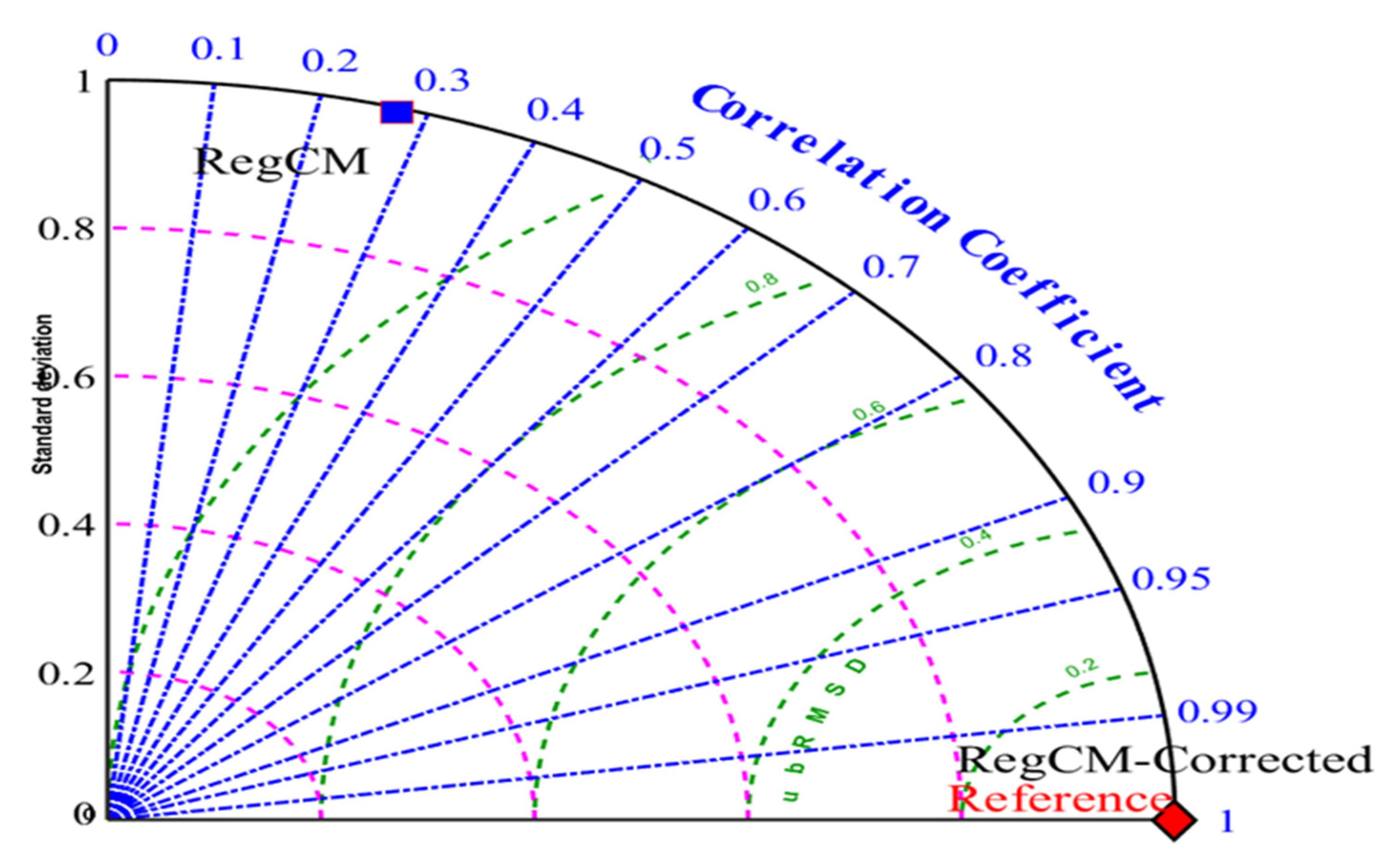
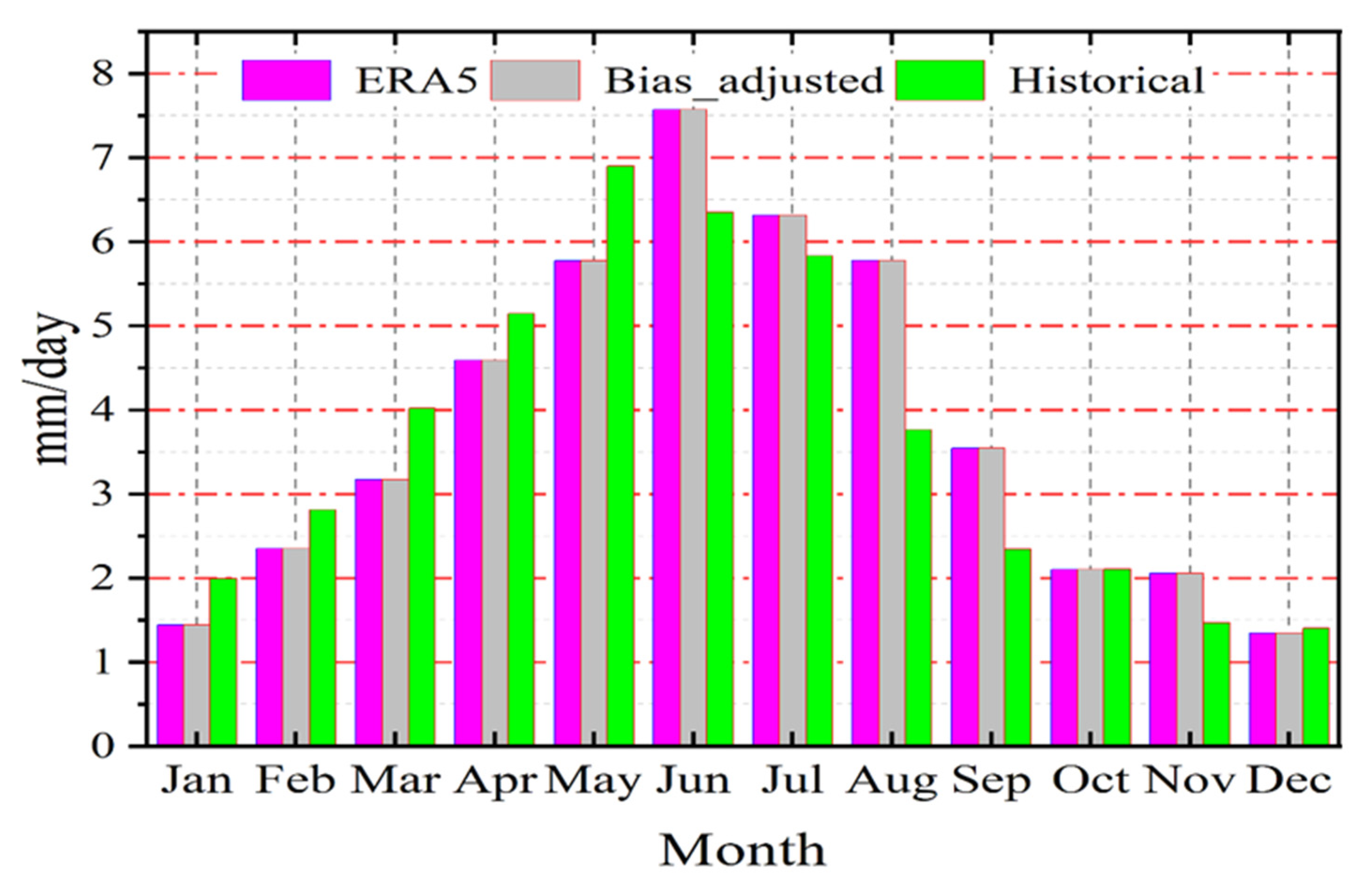
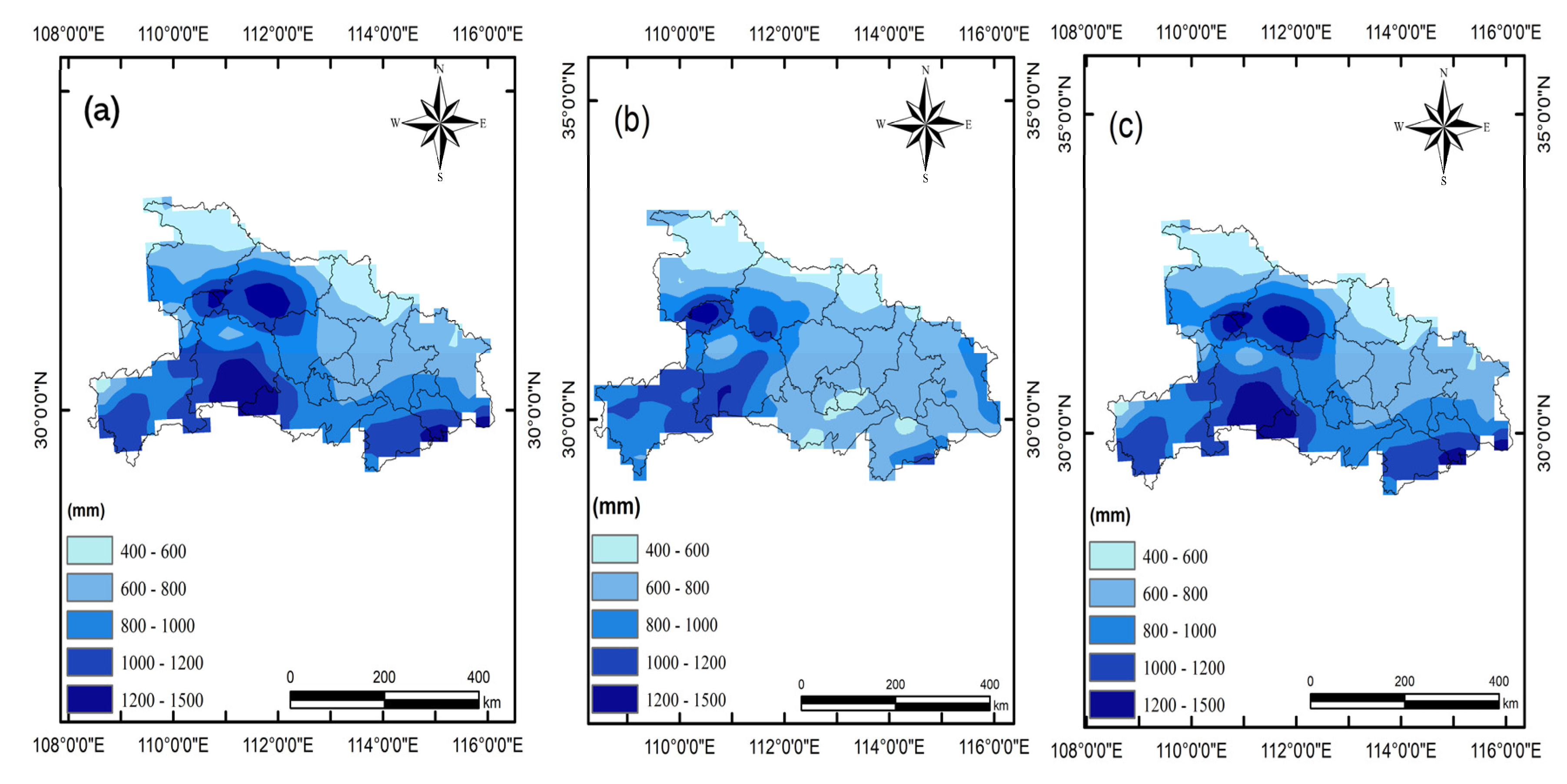
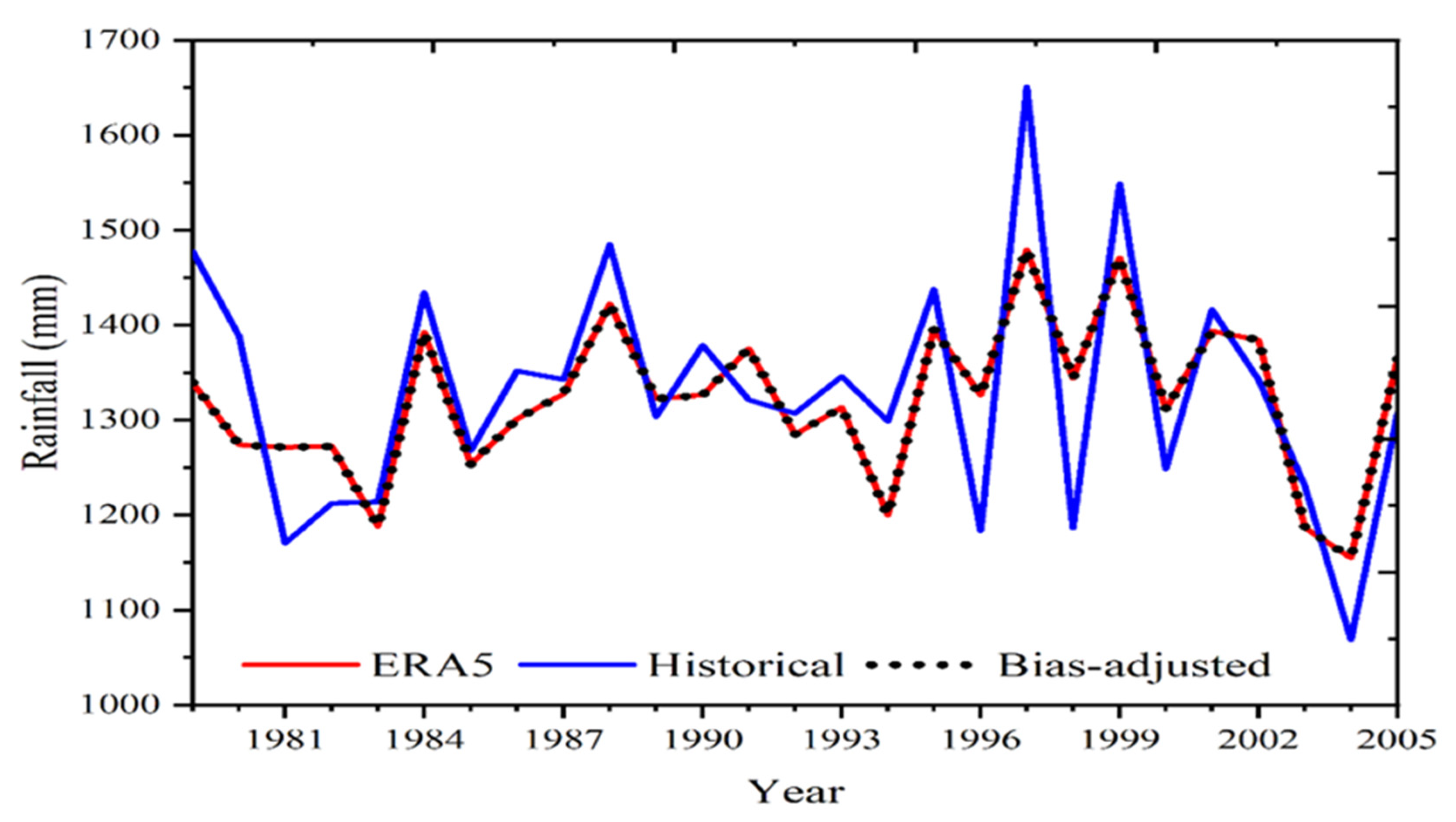



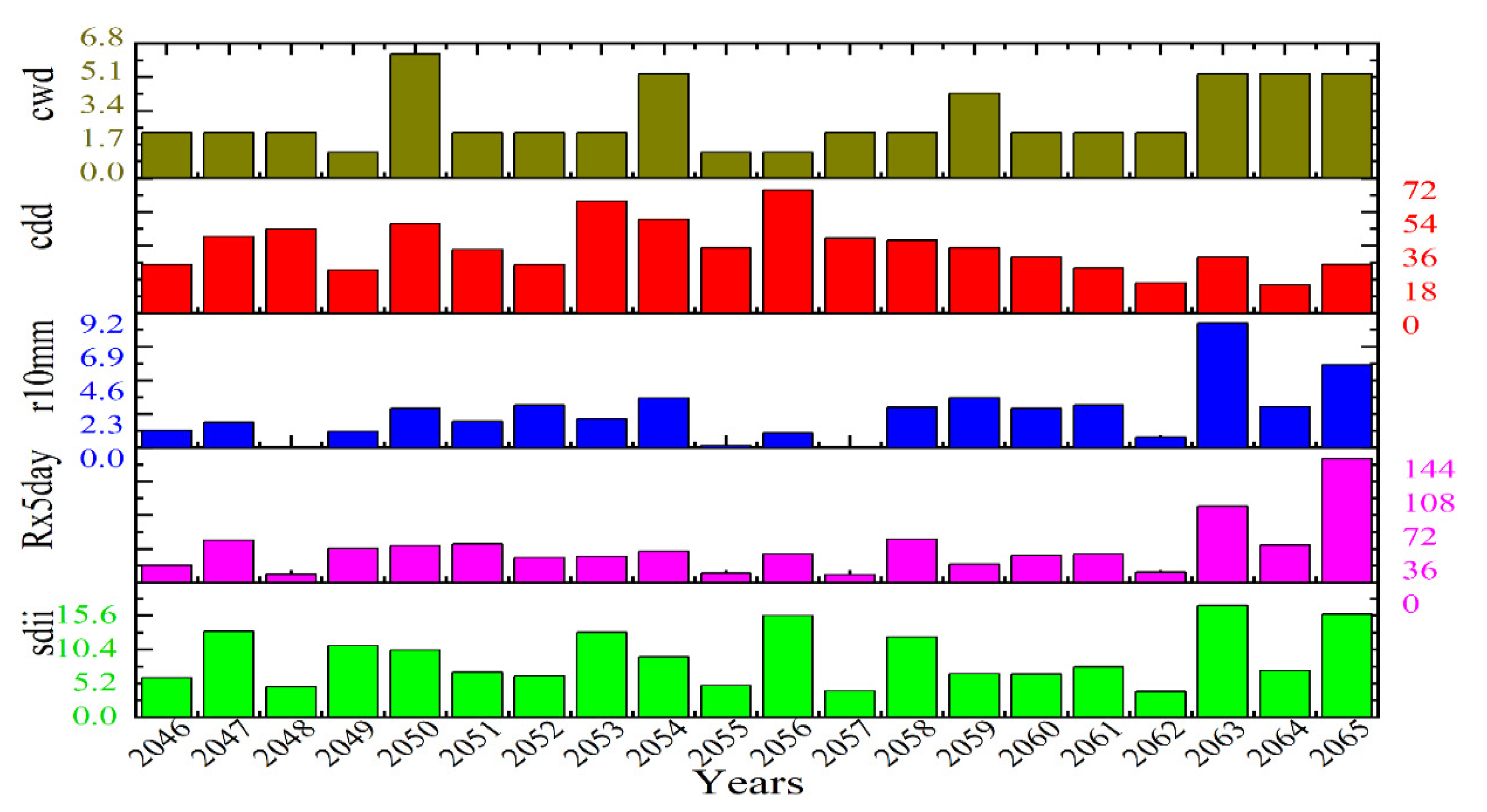

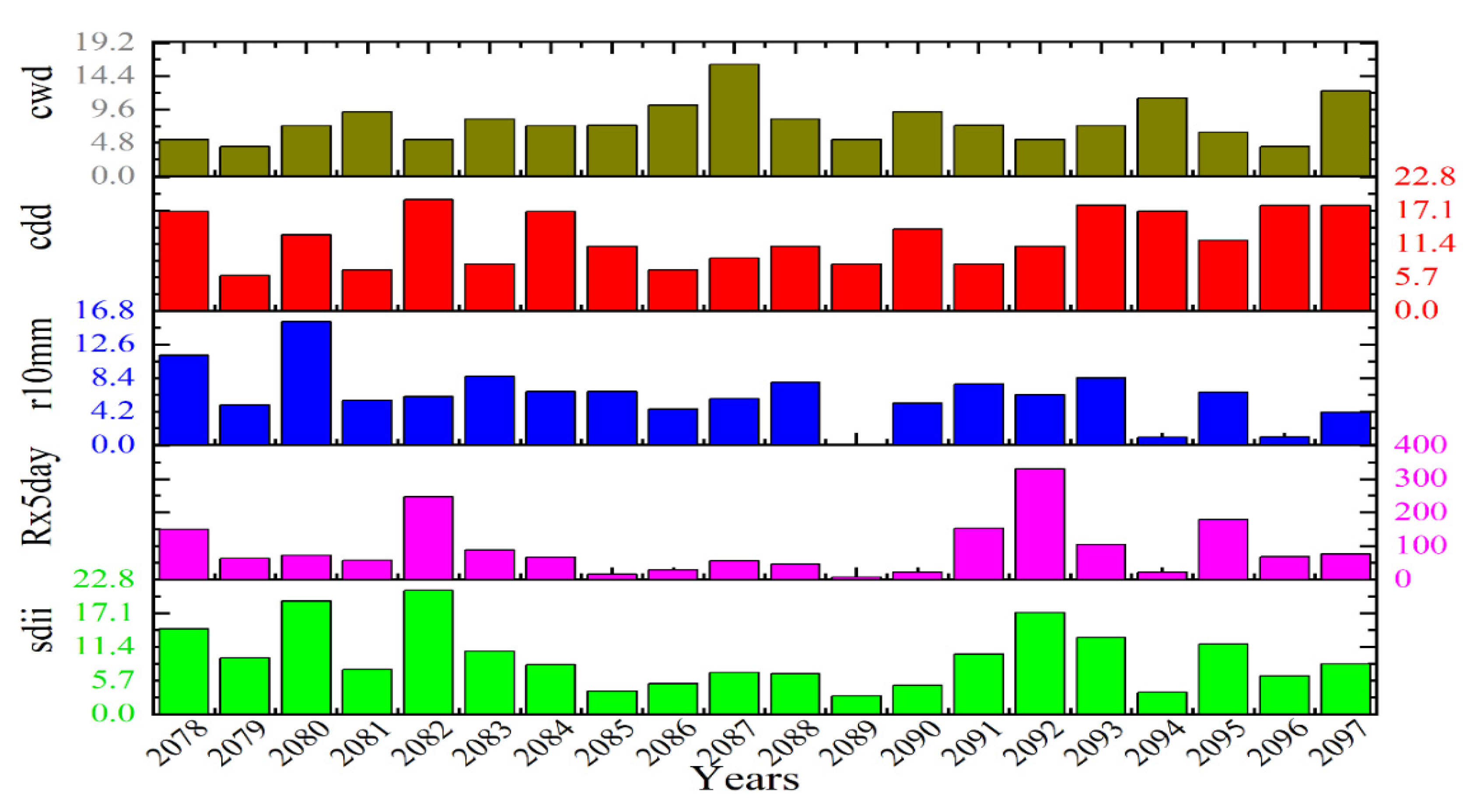
| Indicator Units | Index Name | Definitions | Units |
|---|---|---|---|
| Rx5day | Maximum 5-day precipitation | Annual maximum consecutive 5-day precipitation | mm |
| R10mm | Number of heavy precipitation days | Annual number of days when the daily precipitation is >l0 mm | days |
| CWD | Consecutive wet days | Average daily precipitation on wet days, mm/day | days |
| CDD | Consecutive dry days | Average daily precipitation on dry days, mm/day | days |
| SDII | Simple daily intensity index | Daily precipitation (≥1 mm) in the year | mm/day |
| Mean | Bias | RMSD | RMSE | STD | R | |
|---|---|---|---|---|---|---|
| ERA5 | 3.85 | 0 | 0 | 0 | 1 | 1 |
| RegCM | 3.69 | 0.17 | 4.34 | 4.34 | 0.99 | 027 |
| EPI | S | Z | p | Trend |
|---|---|---|---|---|
| Rx5day | 75 | 1.5427 | 0.12291 | |
| R10mm | 30 | 0.60636 | 0.54427 | Based on the available data, no statistically significant trend was observed |
| CWD | −35 | 0.70879 | 0.47845 | |
| CDD | 41 | 0.88052 | 0.37858 | |
| SDII | 19 | 0.37524 | 0.70748 |
| EPI | High | Low | S | Z | p | Trend |
|---|---|---|---|---|---|---|
| Rx5day | 65 | −30 | 28 | 0.876 | 0.38103 | Non-significant increasing |
| R10mm | 15 | −5 | 64 | 2.044 | 0.040955 | Significant increasing |
| CWD | 40 | −25 | 43 | 1.7195 | 0.16175 | Non-significant increasing |
| CDD | 45 | −15 | −54 | 1.7195 | 0.085515 | Non-significant decreasing |
| SDII | 45 | −15 | 12 | 0.35689 | 0.77029 | Non-significant increasing |
| EPI | High | Low | S | Z | p | Trend |
|---|---|---|---|---|---|---|
| Rx5day | 70 | −55 | −2 | 0.032444 | 0.97412 | There is no statistically significant trend |
| Rx10mm | 15 | −5 | −49 | 1.5581 | 0.1192 | |
| CWD | 20 | −10 | 24 | 0.74622 | 0.45554 | |
| CDD | 25 | −15 | 54 | 1.7195 | 0.085515 | |
| SDII | 20 | −10 | −38 | 1.2004 | 0.22997 |
Disclaimer/Publisher’s Note: The statements, opinions and data contained in all publications are solely those of the individual author(s) and contributor(s) and not of MDPI and/or the editor(s). MDPI and/or the editor(s) disclaim responsibility for any injury to people or property resulting from any ideas, methods, instructions or products referred to in the content. |
© 2024 by the authors. Licensee MDPI, Basel, Switzerland. This article is an open access article distributed under the terms and conditions of the Creative Commons Attribution (CC BY) license (https://creativecommons.org/licenses/by/4.0/).
Share and Cite
Mubark, A.; Chen, Q.; Abdallah, M.; Hussien, A.; Hamadalnel, M. Projection of Extreme Summer Precipitation over Hubei Province in the 21st Century. Atmosphere 2024, 15, 983. https://doi.org/10.3390/atmos15080983
Mubark A, Chen Q, Abdallah M, Hussien A, Hamadalnel M. Projection of Extreme Summer Precipitation over Hubei Province in the 21st Century. Atmosphere. 2024; 15(8):983. https://doi.org/10.3390/atmos15080983
Chicago/Turabian StyleMubark, Abrar, Qian Chen, Mohamed Abdallah, Awad Hussien, and Monzer Hamadalnel. 2024. "Projection of Extreme Summer Precipitation over Hubei Province in the 21st Century" Atmosphere 15, no. 8: 983. https://doi.org/10.3390/atmos15080983
APA StyleMubark, A., Chen, Q., Abdallah, M., Hussien, A., & Hamadalnel, M. (2024). Projection of Extreme Summer Precipitation over Hubei Province in the 21st Century. Atmosphere, 15(8), 983. https://doi.org/10.3390/atmos15080983







